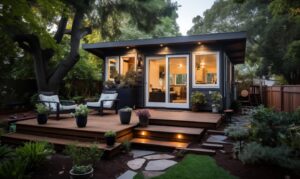Country music singer Maren Morris hit the nail on the head when she wrote: “when the bones are good, the rest don’t matter.” Some of you may be wondering… who is Maren Morris and what are “good bones”? We’ll stay in our own lane for this one.
A home with “good bones” is built on a solid structure and has the potential to stand strong on its land for a very long time. When you are looking to buy or build a house to create a life in, the “bones” are of highest priority. Sometimes a home with good bones will be a “fixer-upper” or a diamond in the rough that just needs a little shining. This is the case when a home may not look too appealing on the outside, but underneath is where the story unfolds.
In reality, outdated décor in a dining room or ugly light fixtures in an entryway should never sway your opinion of a home. Cosmetic issues are easy and typically inexpensive to fix. Trust us, stained carpeting and hideous wallpaper have nothing on a crack in the roof or an inconvenient floorplan. Let’s take a look at 8 key features that give a home “good bones”:
1. Strong Foundation
A solid foundation does more than support the structure of a house. It insulates against the cold, keeps out moisture, and resists movement of the ground around it. In fact, when a home is built on a solid foundation, it can withstand the roughest of climates, storms, and conditions. It is good to keep in mind that different geographical locations and architectural designs call for different types of foundations. Hint: if an old home has its original attributes, such as tile flooring or crown moldings, that’s a good indicator that the home was built on a strong foundation.
2. Durable Roof
A roof quite literally completes a home. Without a roof, the structure of a house would eventually crumble to pieces. So, having a sturdy roof over your head is crucial to feeling safe and comfortable inside your home. You can typically tell when a roof is deteriorating, cracking, or sagging just by looking at it. However, we recommend having a professional evaluate the roofing of a house before you buy it- because replacing a roof is neither ideal nor economical.

3. Practical Floor Plan
If the floorplan of a home does not require much altering and makes sense for your daily needs, consider that a win! An awkward floor plan is hard to overlook and comes with expensive consequences like plumbing and electrical rewiring if you plan to renovate. A well-designed floor plan incorporates rooms that flow well with one another and allow for good use of space. Be on the lookout for desirable floor plans that are functional, efficient, and easy to navigate for daily use.
4. Proper Plumbing
When assessing a property, one of the first things you should do is check the water and drain lines. Plumbing issues can cause other factors in your home to lose their health, which could lead to many of the “bones” going bad. Are the pipes, toilets, showers, and sinks in good condition? No drainage problems? No visible water damage around the property? You should be in the clear! That’s a home with like-new plumbing that should last as long it’s on your watch… or in the hands of a good plumber.
5. Smooth Ceilings and Walls
When evaluating the bones of a house, always peek for cracks or discoloration on the walls and ceilings. Large faults or cracks typically mean something is stretching unusually, and it may require significant, expensive labor to fix. Healthy walls and ceilings without cracks or discoloration often reflect the quality performance of the foundation and plumbing. Housing issues can often feel like a ripple effect when something goes wrong!
6. Solid Flooring
When you step into a home (after removing your shoes, assuming you practice good manners), the first physical point of contact you experience is with the flooring. Floors are the foundation of your home design and the element that takes up the most real estate in every space. Therefore, the floors directly impact the way you experience your home. You want to ensure that the flooring is not sagging in any areas and it constantly feels solid to walk on. Many homeowners consider having wood floors underneath carpeting as a bonus!

7. Natural Light and Windows
Let’s face it, living in a home with little access to sunlight sounds a bit miserable. So, when you build or buy a home it’s important to ensure that there are large windows that provide natural light throughout the house. We recommend assessing the lighting throughout the home at all times of the day. For instance, if you enjoy watching the sunrise on your couch with a cup of joe in the mornings, you want to be sure you have a living room window that faces the east. Always prioritize the little things in life that bring you joy!

8. Appealing Location
There are a lot of things you can change about a house, but the location is not one of them. Physically moving a house… tough to do! So, make sure the house you are buying or building is in an appealing, safe area and on a sizeable lot. This factor will play a large role in whether or not you stay in a house for a long period of time. Once you have secured the ideal location, you have officially checked off the last ingredient on our “good bones” list.
Now, back to the main chorus!
“Yeah, the paint could peel
The glass could shatter….
The house don’t fall when the bones are good”






